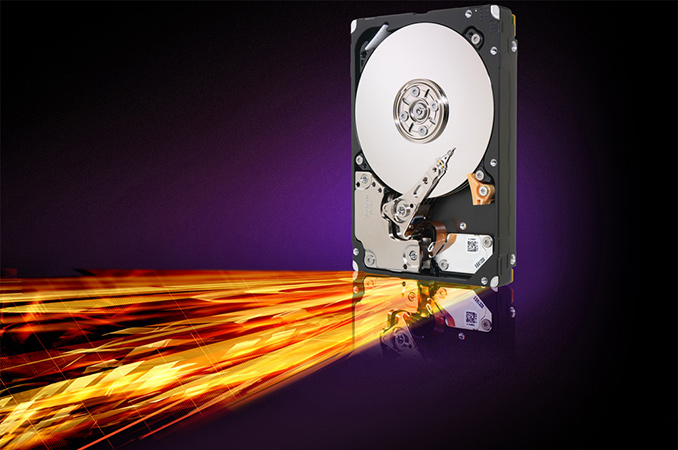The Evolution of HDDs in the Near Future: Speaking with Seagate CTO, Mark Re
by Anton Shilov on July 6, 2016 2:00 PM EST
In the recent months, Seagate has made several significant announcements regarding the future of HDD technology and unveiled a number of important products. In particular, late last year the company has said that hard disk drives would continue to evolve in the following 20 years, implying that Seagate is exploring multiple technologies to improve capacities and performance of HDDs. Additionally, Seagate introduced the first shingled magnetic recording (SMR) based consumer drives for mobile PCs, which marks a significant milestone in the development of the technology.
The Evolution Continues, New Challenges Arise
While solid-state storage devices are evolving fast in terms of performance and getting more affordable every year, they are not going to match hard drives in terms of cost-per-GB anytime soon. Still, with economic feasibility in place, HDDs are poised to keep evolving with larger capacities and better performance. Throughout the history of hard drives, the evolution of HDDs has involved multiple factors, including materials (platters), mechanics (motors, arm movers, internal structure, and so on), read/record heads, controllers and firmware.
The keys to additional capacity and performance of HDDs have remained generally the same over the years: small pitches and narrow tracks as well as a high rotating speed respectively. The evolution of HDDs in the future will rely on platter density and new heads, as well as the compute capabilities of their controllers. The performance of HDD controllers in the coming years will matter more than ever.
For our coverage, we approached Seagate and spoke with Mark Re, SVP and Chief Technology Officer of Seagate, to discuss their plans to announce HDDs featuring other important technologies. Rather than a question/answer discussion, what follows is a culmination and expansion of topics discussed.
Sources and Recommended Reading:
Seagate: Hard Disk Drives Set to Stay Relevant for 20 Years
Hard Disk Drives with HAMR Technology Set to Arrive in 2018
Market Views: HDD Shipments Down 20% in Q1 2016, Hit Multi-Year Low











91 Comments
View All Comments
mkozakewich - Thursday, July 7, 2016 - link
Oh, I remember that article. Higher write temperatures mean better longevity, right?twelvebore - Wednesday, July 6, 2016 - link
Guessing that you don't buy storage by the petabyte then? You know, horizons and all that.Ushio01 - Wednesday, July 6, 2016 - link
With 2.5" SSD's available today offer lower power, higher capacity, higher performance and higher density than 3.5" HDD's. I wonder how much that offsets the higher cost per GB?twelvebore - Wednesday, July 6, 2016 - link
Higher capacity? A 10TB 2.5" SSD for <£500? Where?Lower power than an HDD that's powered off?
Performance doesn't always matter.
The article says several times, this is not about desktop. This is about data-centre, extreme capacity, price-sensitive. These HDDs are competing with magnetic tape, not SSD.
jwhannell - Wednesday, July 6, 2016 - link
Flape.patrickjp93 - Wednesday, July 6, 2016 - link
Performance/Watt/$ is the most important metric, and HDD is already under immense pressure from archival SSDs.patrickjp93 - Wednesday, July 6, 2016 - link
For enterprise use that's a $2000 drive, unless you're using one without power loss protection and ECC... And Samsung already has one provided.Murloc - Wednesday, July 6, 2016 - link
It doesn't offset the cost at all if the only thing that matters is $/GB.amnesia0287 - Wednesday, July 6, 2016 - link
You don't seem to understand how datacenters work. SSDs and modern JBOD infrastructure are changing the way this is approached. The thing you gotta realize is you can pack SSDs INSANELY dense. Yes, the power difference of 1 ssd is menial, but when you fill a rack with them, the combined power and cooling savings add up, especially if you are aiming for a minimum 2-3 year run cost.You also have to bear in mind that datacenters are pretty much exclusively using substantially more expensive (and hotter/louder) SAS drives.
Capex is important, but you are totally ignoring Opex and TCO. Also AFR is about 1/6th (.5% vs 3%) which gives you more flexibity in your planing for consistency/redundancy. SSD failures are more or less predictable.
Either way the move to SSDs in the datacenter is VERY real, as density is king. Why waste money expanding into more datacenters and adding more racks? SSDs also solve alot of problems that HDD have such as large array rebuilds.
Also tech like RDMA combined with NVMe virtualization is going to fundamentally change the landscape.
zodiacfml - Friday, July 8, 2016 - link
Correct. SSDs have higher density already and the rich companies can afford them.